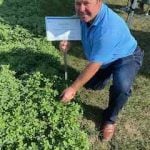ALBERTA
SOUTH
Pea harvest underway
Harvest is slow. Swathing of canola is well underway, but harvest is delayed by continual showers. Winter wheat harvest is more than half finished with strong yields. Pea harvest has begun. Early potato harvests are underway and the main potato harvest will begin shortly. Some second cut hay has begun. Overall yields look good.
CENTRAL
Frost reported
Canola swathing is well underway. Frost was reported but it’s too early to tell if there was damage. Pea harvest has started, but rain and cool days are making drying difficult. Some peas are in aeration bins to dry down. Desiccation of cereal crops has been sporadic because of wet weather.
Read Also

Agriculture ministers commit to enhancing competitiveness
Canadian ag ministers said they want to ensure farmers, ranchers and processors are competitive through ongoing regulatory reform and business risk management programs that work.
NORTHWEST
Rain delays swathing
Harvest is off to a slow start because of frequent showers. Some winter cereals and peas are harvested. Little crop has been swathed with the exception of canola. Pastures are growing with the continual rain and grass land has been given a boost.
NORTHEAST
Pea, barley yield good
Frequent showers have slowed harvest and haying progress. Harvest has begun on early maturing crops. Some field peas and barley are harvested with good yields. Swathing is getting underway. It is too early to tell if frost has harmed crops.
PEACE AND B.C.
Poor canola yields
Harvest is well underway. Dry conditions forced crops to mature early. Sporadic rains during harvest have slowed harvest progress. Canola is coming off the fields with poor to average yields. Most cereals harvested have poor yields. Pasture and hay land has dried up and producers have started selling livestock. Subsoil moisture is poor.
MANITOBA
INTERLAKE
Crop quality poor
Wheat harvest is about 80 percent complete in the south, but crop quality is poor and averaging a grade of three due to high levels of fusarium in the crop. Harvest is less advanced in the north. Canola yields vary greatly due to excess moisture and drowned out fields. High and low yielding crops average out to 20 bu. per acre.
NORTHWEST
Wheat harvest bright
Approximately 50 percent of canola fields have been swathed. Spring wheat is further along, with 25 to 30 percent of the crop in the bin. Wheat quality has been good to average, with most crops coming in at No. 1 or 2. Producers east and northeast of Dauphin have struggled to harvest the first cut of tame hay in wet conditions.
CENTRAL
Cereal harvest finishing
The cereal crop harvest is nearly complete and about 75 percent of the canola fields have been combined. The leaves on soybean plants are starting to yellow and fall off, but combining is a few weeks away. Rainfall, 25 to 75 mm across the region, has increased the risk of sclerotinia in sunflowers.
SOUTHWEST
Harvest underway
Harvest is further advanced south of Souris, but producers have combined about 20 percent of the canola crop. A few fields have yielded 50 bushels per acre, but most are in the 30 to 35 bu. range. Tame hay yields are good at 30 to 40 percent higher than average, but quality has been poor. Protein content and relative feed value are lower than normal.
EASTERN
Rain delays combining
Heavy rains, with 50 to 100 mm around Steinbach, will delay the harvest of remaining cereal and canola crops. Yields and crop quality are poor in the northern half of the region, due to excess moisture. Canola crops north of St. Pierre are yielding only 10 to 20 bu. per acre and wheat is 10 to 25 bu. per acre. South of St. Pierre, canola has yielded 30 to 45 bu. per acre and oats are topping 100 bu. per acre.
SASKATCHEWAN
SOUTHWEST
Frost a threat
Harvest was progressing until rain arrived. About 15 percent of the crop is combined and slightly more swathed or ready to straight cut. Crop yields are good with barley under 50 bushels per acre, canola under 30 bu. per acre and peas 30 bu. per acre. Temperatures have hovered close to freezing.
SOUTHEAST
Sprouting a problem
About 14 percent of the crop is combined and 30 percent of the crop is swathed. The rain is causing concern about disease in ripening pulse crops. Sprouting and bleaching in swathed cereals are also a concern. Wet fields are causing problems. Some farmers are dumping grain into grain carts on the road because the fields are soft. Heavy dew in the morning is shortening available combining time.
WEST-CENTRAL
Disease in lentils
Good harvest progress was made. About six percent of the crops are combined with another 18 percent swathed or ready to straight cut. Most crop damage is due to disease. Lentils are showing high disease pressures. Crops are behind in development.
EAST-CENTRAL
Poor hay quality
About four percent of the crop is combined and about 26 percent is ready to be swathed. There are water logged fields, drowned out patches, weeds and insect damage. Hay quality is generally poor. Wet land is keeping farmers off the field. Crop quality is being reduced in the swath. Some winter wheat is being seeded, although most fields are wet.
NORTHWEST
Waterfowl a problem
Good haying progress was made although some farmers have more mowing and baling to do. Wind and waterfowl are causing crop damage. Disease in pulses is also a problem. Some crops are lodging in areas that received heavy rain recently.
NORTHEAST
Damage from lodging
Significant harvest progress was made. About two percent of the crop is combined and about 25 percent is ready to be swathed or straight cut. There is crop damage due to disease and crop lodging from wind. Farmers are controlling weeds on unseeded acres. Fields are wet in areas and swathers are getting stuck.














